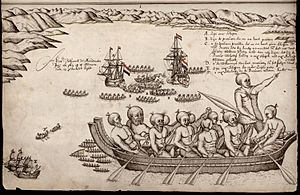Golden Bay facts for kids
Quick facts for kids Golden Bay / Mohua |
|
| Bay | |
| Country | New Zealand |
|---|---|
| Coordinates | 40°40′S 172°50′E / 40.667°S 172.833°E |
Golden Bay / Mohua is a beautiful bay located at the northwest end of New Zealand's South Island. It's shaped a bit like a wide, shallow bowl. This bay is part of the Tasman Sea and sits northwest of Tasman Bay and Cook Strait.
A long, thin strip of golden sand called Farewell Spit protects the bay from the north. This sandspit is 26 kilometers (about 16 miles) long and is the longest one in New Zealand! Two rivers, the Aorere and Takaka, flow into the bay from the south.
Golden Bay is a popular spot for tourists. People love to visit because of its sunny weather and friendly, relaxed atmosphere. The bay used to be a resting place for migrating whales and dolphins, like Southern right whales and Humpback whales. Sometimes, even Pygmy blue whales can be seen near the bay.
Most of the western and northern parts of the bay are quiet and not many people live there. Along the southern coast, you'll find the towns of Takaka and Collingwood. The famous Abel Tasman National Park is also located here. The natural border between Golden Bay and Tasman Bay, called Separation Point, is inside this park. The base of Farewell Spit is close to the North West Nelson National Park.
In December 2011, Golden Bay and the surrounding Nelson/Tasman region experienced heavy rain and flooding. This affected many homes, especially around Pohara, Ligar Bay, Tata Beach, and Wainui. The road to Totaranui, a popular isolated tourist spot, was badly damaged but was reopened in June 2012.
Beaches like Tata Beach are favorite places for people to retire or have holiday homes. The bay is part of the Tasman District, which is one of New Zealand's local government areas.
Contents
History of Golden Bay
Early Maori Settlement
Maori people have lived along the shores of Golden Bay for a very long time. The earliest signs of their presence, found by scientists, date back to at least 1450. In 2010, a team from Otago University studied many early Maori sites in the bay. They found places like pā (fortified villages), kainga (unfortified villages), and even possible kumara (sweet potato) gardens. These sites stretch along the coast for about 60 kilometers.
Around 1642, the iwi (tribe) living in this area was called Ngati Tumatakokiri. They had only recently moved to this part of the South Island.
Abel Tasman's Visit
In 1642, Dutch explorer Abel Tasman became the first European to visit the bay. He anchored his ships about 7 kilometers (4 miles) offshore. There was a fierce encounter between Tasman's crew and the Ngati Tumatakokiri Maori. Maori warriors in waka (canoes) attacked one of the Dutch boats, killing four seamen. Because of this event, Tasman named the bay Moordenaar's Bay, which means Murderers Bay.
Some historians believe the Ngati Tumatakokiri tribe might have felt uncertain about their control over the bay. This could be because they had only recently arrived in the area themselves. Not much is known about the Ngati Tumatakokiri people. They were later defeated by another Maori invasion during the Musket Wars around 1823.
Tasman saw at least 22 waka in the bay. He noted that most of the 11 waka that chased his ship had 17 men on board. This suggests there were about 200 warriors, and likely around 500 people living in the area. Tasman had been in the bay for five days before the attack, giving the Maori time to gather their forces. Scientists haven't found any very large settlements from that time. This suggests the iwi probably lived in smaller family groups scattered along the coast. Many lived in the eastern part of the bay, around Ligar Beach, Tata Beach, and Wainui Bay.
Later European Explorers
In 1770, during his first journey, English explorer James Cook thought this bay was part of a larger area he called Blind Bay. However, on his second trip to the bay in 1773, he realized it was actually the same place Tasman had called Murderers Bay. Later, a French explorer named Jules Dumont d'Urville seemed to change the name again to Massacre Bay.
European Settlement and Name Changes
European settlement in Golden Bay began in October 1842. The Lovell family was among the first to settle near Motupipi, close to an existing Maori pa site. Before they arrived, in March of that year, a Mr. Tuckett had found coal on the beach near Motupipi. There was also an earlier report from May 1841 mentioning coal in the area.
In the 1840s, after these discoveries, local settlers tried to get the bay renamed Coal Bay, but this didn't happen. Then, in the late 1850s, gold was discovered in the Aorere area. Because of this exciting discovery, the bay's name was changed to Golden Bay.
In August 2014, the bay's name was officially changed to Golden Bay / Mohua. This new name includes both the English and Maori names for the bay.
Images for kids





